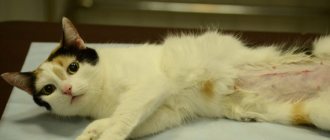Caring for a dog after sterilization on the first day
The first day after sterilization is especially important for the animal. When recovering from anesthesia, the dog may behave inappropriately, may pee under itself, or fall out of a chair or bed. For this reason, it should not be placed in elevated places. The bed must be covered with a sterile disposable diaper (sold in pharmacies) and changed regularly when it gets wet.
Sterilization operation
Important! If urinary incontinence occurs for a long time after the release of anesthesia, consultation with a veterinarian is necessary.
The place for the operated dog should not be in a passage, in a draft, or near heating devices. It is advisable to cover the bitch with something warm on top so that she does not get pneumonia, since at this time the body temperature drops and life processes slow down.
Anesthesia after surgery usually wears off within 2-3 hours, but it will take at least a day for the dog to finally come to its senses. At this time, you should not leave the dog for a long time. Anesthesia can cause panic in an animal, a feeling of anxiety, and unreasonable aggression. This is not something to be afraid of. Everything will return to normal as soon as the anesthesia completely leaves the body. At this time, you need to stay close to your pet, create a quiet, calm environment for him, and warn your family not to disturb him.
Note! The answer to the question of how long it takes a dog to recover from anesthesia after sterilization depends on the drug administered, its dosage, and the characteristics of the animal’s body.
The first day after surgery
Upon arrival home, it is advisable to lay the operated dog on a flat surface with bedding (preferably on the floor so that it cannot fall while moving) and cover it with a blanket. Periodically, you should moisturize the oral mucosa by dripping a few drops of water into your mouth. During recovery from anesthesia, reflex urination may occur, so you need to be prepared to replace the bedding.
The animal can come to its senses almost immediately or after a few hours - it depends on its body and the dose of anesthetic. The first sign that the dog will soon wake up will be its reaction to irritation - twitching of its paws or ears. Since motor reflexes are not restored immediately, the animal may feel weak and helpless for some time, but this does not last long.
Important! As soon as the dog is fully awake, you need to offer him water or wet his nose and tongue with water. The animal should not be fed on the first day after surgery, as vomiting may be a reaction to food.
While the dog is under anesthesia, it is advisable to ensure constant monitoring. If everything is going well, your breathing and heart rate should be rhythmic. A slight increase in temperature is acceptable, and short-term periodic muscle twitching or trembling may occur.
The need for blankets
Cat after sterilization: care at home
After the sterilization operation and treatment of the sutures, in order to prevent infection from entering the wound, the dog is put on a special blanket, and, if necessary, a collar. A postoperative blanket is also necessary to prevent the dog from licking the seam. It also supports the abdominal cavity, preventing the formation of hernias and suture divergence.
The blanket should always be clean. When going outside with your pet, it should be protected with a jumpsuit, and if it gets dirty, change it for a clean one. During a winter walk, the blanket is insulated on top to prevent the seams from getting cold. This accessory is worn, if there are no complications, for 2-3 weeks. During this time, the pet should not be subjected to physical stress.
Postoperative blanket
The dog may not like wearing foreign things; it will try to take it off, refuse to eat, and in every possible way show inconvenience in movement. You should not follow the dog’s lead, as this is fraught with bad consequences. While your pet is recovering, wearing a blanket is essential.
Caring for your dog after castration
After the operation, the dog will be under the influence of anesthesia for several more hours. Release time is individual. The owner or staff of the clinic must be close to the operated animal.
The dog is placed on a waterproof oilcloth - for the first hours after anesthesia, the animal’s urethra is relaxed and cannot hold urine. The animal's pulse and respiratory rate are checked.
After the dog stops urinating on itself, it can be transferred to a clean cotton bedding. Place it on the floor so that the animal does not accidentally fall. During the period of recovery from anesthesia, the male dog will have impaired coordination. Don't leave him alone!
There is no need to offer water or feed immediately after recovery from anesthesia. This can be done a few hours after surgery. Ask the doctor who performed the castration when is the best time to do it. It is not scary if the animal refuses to eat for the first 2 days after surgery.
Postoperative period and wound care
- There is no need to apply bandages to the surgical area. Healing occurs faster in the open air.
- Use an Elizabethan collar if the animal tries to lick a wound.
- If the surgical area is red or swollen, it is treated with Chlorhexidine (a liquid antiseptic).
When is an urgent need to contact a veterinarian?
If the condition of the wound or your pet worries you, take it to the veterinarian.
Indications for urgently calling a doctor:
- The male refuses to eat for more than 2-3 days.
- In the first 24 hours after the procedure, a high temperature rises.
- The dog is breathing heavily, his oral mucosa has turned red or pale.
Video - care after surgery:
Seam processing
At home, the sutures of the operated animal are regularly treated with a disinfectant, then with an ointment or aerosol 2 times a day until they are completely healed. The crusts formed after the operation are moistened with hydrogen peroxide until they soften, then removed.
After sterilization, the cat asks the cat: is this normal and what to do?
If the wound is poorly treated or licked, an inflammatory process may begin. When an infection gets into the wound, the animal vomits, the temperature rises, increased thirst appears, and the heartbeat quickens. Such symptoms require immediate medical examination and a course of antibiotics.
Note! If your dog whines after sterilization or is in pain, you can give painkillers after consulting with your doctor.
Postoperative sutures
Suture care after dog sterilization
Initially, the suture after sterilization of the dog is processed by the surgeon who performed the operation. After that, the patient is put on a postoperative blanket, in which your pet will walk for several days. If necessary, the doctor will also recommend wearing a special collar.
Further care consists of monitoring healing and, if necessary, treating the sutures after sterilizing the dog with an antiseptic. Antibiotic therapy may also be prescribed to exclude inflammatory processes. In the normal course of healing, this is enough. Depending on the choice of suture material and other nuances, the treatment may differ or not be required at all; your doctor will tell you about this. He will tell you whether there is a need to remove the stitches and when this can be done.
However, if the stitches become wet, fluid is released, or the dog’s temperature is lower or higher than normal, a second consultation is necessary.
Our clinic’s specialists prefer cosmetic sutures that do not require removal. In this case, seam maintenance will be minimal. Another plus is that a repeat visit to the clinic, which can be additional stress for the dog, is not required.
In the photo you can see the difference between a regular seam and a cosmetic one.
Features of skin and coat care
Due to the removal of the uterus and gonads, a hormonal imbalance occurs in the body, which in turn leads to disruption of the natural change of hair and undercoat. Shedding of hair in bitches usually occurs after the cessation of estrus.
Chihuahua: care and maintenance at home
In the absence of estrus as a result of surgical intervention, the body stops sending signals about a change in coat, the fur begins to grow randomly and profusely, which leads to a change in the appearance of the pet. In this case, the dog needs additional care for its coat.
Note! Skin and coat care depends on the dog's breed and coat type.
Short-haired dogs, such as Dobermans, dachshunds, Dalmatians, pugs, and hounds, are not subject to any special changes in their coat. In long-haired breeds with undercoat, such as Akita Inu, Husky, Spitz, Corgi, Shepherd, a side effect of sterilization can be an abundant growth of undercoat, which requires frequent combing or plucking.
In dogs such as the Poodle, Yorkshire Terrier, Bichon Frize, and Maltese, the outer coat and undercoat differ little from each other; they do not undergo significant changes during sterilization.
Most often, the coat of dogs with a mixture of long and short hair undergoes changes. These include spaniels, retrievers, setters, greyhounds, Pekingese, Japanese chin and others. Their fur becomes softer, so it mats quickly and difficult to comb tangles form. As a result, the dog's appearance suffers. In this case, the wool requires additional care.
Grooming
The hard, wiry coat of Shih Tzus, Giant Schnauzers, Afghan Hounds, and some types of terriers also suffers. As a result of sterilization of the animal, it loses its natural rigidity, becomes softer, and requires cutting with scissors instead of the usual trimming, which can only increase the growth of fluffy and soft fur.
Nutrition during the recovery period
You can feed your dog no earlier than 10 hours after sterilization. Before feeding, fluids must be provided. After surgery, dogs often experience constipation, which is accompanied by pain. This must be regulated with nutrition until digestion is restored.
Food should be given in a pureed, semi-liquid state in small portions, but often. The food should be well balanced and include dairy products. If the dog refuses to eat and only drinks water, there is no need to force it to eat. You should start to worry if your pet refuses to eat food for more than three days.
What to do if your dog won't let you approach him
After anesthesia, a dog may behave inappropriately and may begin to hallucinate. She may not recognize the owner, not allow anyone to approach her, or behave aggressively. In such cases, doctors advise not to panic, you just need to wait for time, calmly observing her, and help her calm down. This behavior will go away as the anesthesia leaves the body.
Sad pet
Post-operative care
It is best to do it on Friday evening. Then you will have the weekend to watch your pet. The operation is performed under anesthesia, so it takes time for the dog to recover from it. This usually takes from several hours to a day. Adhere to the following rules:
- Place the dog on a flat surface, not high from the floor.
- As soon as she wakes up, give her water.
- Blot the seam with a napkin and treat it with brilliant green.
- Start feeding within 24 hours.
- Make sure she doesn't lick the seam. A bandage is sometimes worn for this purpose.
- On the third day, the dog completely returns to its usual rhythm of life.
- Treatment of the affected area should be carried out for up to 10 days.
Caring for the dog after sterilization is carried out under the supervision of a doctor. If necessary, he prescribes antibiotics.
Possible complications in a dog after castration
After castration, the animal may lack appetite. The reason for this may be the blanket. In such cases, it is removed for feeding and then put on again.
When processing seams, you should pay attention to the color of your pet's skin. Its pale appearance may indicate internal bleeding, which may occur due to poor blood clotting or inept actions of the operating veterinarian.
Another complication after surgery can be ruptured internal sutures. Lumps under the skin are formed as a result of the prolapse of internal organs beyond the walls of the abdominal cavity. Also, after anesthesia, problems with the knee joints are possible.
Seam care
Recovery for males and females proceeds differently. Strip and local operations differ in complexity and method of care.
The healing period requires special monitoring of the pet's condition:
- During the first week, you will have to inspect the suture line every day. Pay attention to the presence of inflammation and suppuration. Redness and fever are acceptable;
- use chlorhexidine and hydrogen peroxide to treat the suture;
- isolate the area from mechanical action. The animal shows increased interest in the wound, trying to bite, scratch, and lick it. The bandage is required to distract attention. It is worth considering that your pet will try to take off excess “clothes”, so you need to check the tightness of the fit at every opportunity;
- keep an eye on the bed. The material must remain dry. If the “corset” is accidentally torn off, return it to its place as quickly as possible.
Important! Recommendations on how to treat a sterilization suture on a dog are given by a veterinarian. Avoid self-medication methods.
When is a veterinarian needed?
In general, animals tolerate sterilization without complications. But there are times when the help of a veterinarian is necessary. Such cases include:
- lack of urination for more than a day;
- absence of stool for more than 2 days or the presence of blood in the stool;
- pale or bluish skin;
- cardiopalmus;
- convulsions, fainting;
- difficulty breathing with an open mouth, wheezing;
- increase or decrease in temperature.
The reason for contacting a veterinarian is also suppuration of the wound, bleeding from it, vomiting, prolonged apathy, and lethargy.
Many postoperative complications can be avoided by strictly following the rules of care, a detailed list of which can be obtained from a veterinary clinic. If any deviations in the animal’s behavior are observed, it is necessary to immediately show it to a doctor and undergo a course of treatment.
Dog behavior after sterilization
Owners are often interested in how dogs’ behavior changes after sterilization. It is necessary to distinguish between the dog’s behavior during the period of recovery from anesthesia and how the dog’s character will change after sterilization. The deep anesthesia used during this operation can have a number of consequences visible in the animal's behavior - lack of coordination of movements, sudden aggressiveness or fear, the animal may not recognize its owners or be in the grip of hallucinations.
This is a natural reaction that passes quickly and does not require outside intervention. Be nearby, talk to your pet in a gentle voice, and if he is afraid of you or shows aggression, leave him alone and watch from the side.
The changes in character are mostly positive:
- the likelihood of escapes during estrus, dictated by sexual desire, is reduced;
- aggression towards fellow tribesmen decreases;
- the marking instinct is reduced (especially if the operation is performed at an early age, before the dogs reach puberty).
However, if before sterilization the bitch showed strong dominant qualities, sterilization will be a factor that can strengthen them, since the compensating effect of female hormones will decrease.
Other possible consequences that can result from sterilizing dogs:
- weight gain (obesity) - quite easily controlled by choosing the diet and physical activity of the dog;
- Urinary incontinence can occur mainly in large and older dogs. There are developed drug treatment regimens for such problems, on which specialists at our clinic can advise you;
- alopecia - baldness associated with hormonal imbalance is also corrected by prescribing medications that our doctors can select;











